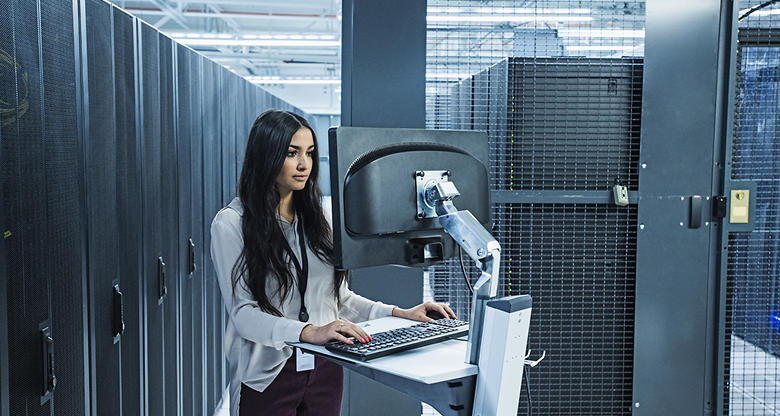The survey shows that more than 70% of businesses have dipped into cash reserves to buy new IT and office equipment for their staff to work from home. However, leasing rather than buying new equipment may be a more cost-effective way to manage the financial challenges of keeping IT and other assets up to date.
More than two in five businesses (42%) said they had invested in new IT hardware to support their staff at the start of pandemic lockdowns in 2020 when Australian employees frantically set up workspaces in living rooms and on kitchen tables.
Hospitality, health, education and the services sector increased their IT spend the most out of the industries surveyed.
Two years on, and with mobile and hybrid work arrangements the new normal, 40% of businesses that increased their IT spend in the pandemic reported that they would continue to invest in IT assets.
What’s surprising is that a staggering 71% of those surveyed used cash reserves to purchase new IT and office equipment outright to support staff working from home.
That compares with just 23% that purchased vehicles outright and 38% that bought machinery with cash.
The data comes from ACA Research, which was commissioned by CommBank to survey Australian businesses of all sizes in May and June 2022 about their purchasing and finance needs. It collated responses from 807 key decision-makers.
The problem with owning IT assets
Sinking money into IT hardware can be problematic for businesses. IT equipment has a limited lifespan and once delivered, quickly loses its value, says Chris Moldrich, General Manager, Asset Finance at CommBank.
He adds that although businesses can claim interest and depreciation on ageing IT assets at tax time, after a few years they are left with out-of-warranty, dated IT equipment that may prove difficult to sell.
“Any tax savings are likely to be eaten up by the cost of paying an external organisation to wipe the machines of any confidential business data and dispose of the equipment,” he says. “This is especially true for medium and larger businesses.”
Running older equipment can also lead to higher maintenance charges and result in down time for the business due to obsolete tech.
How leasing IT can save on costs
One solution to these challenges can be to lease rather than buy. Moldrich says leasing equipment that depreciates rapidly instead of buying it has many benefits for businesses.
“Costs can work out to be lower than an outright cash purchase over time,” he explains.
“Leasing can also prevent the inefficiencies and expenses that come with owning obsolete equipment. By leasing, you’re effectively transferring the ownership risk to the lender.”
He also has a strategy for businesses that may have dipped into their capital reserves to pay for IT assets, then find they need that cash later.
Using a sale and leaseback arrangement, they sell their assets to a financer and lease the equipment instead.
“Where suitable, we can buy back those assets, which puts cash back into the business,” Moldrich explains. “We then structure a finance agreement around the customer’s seasonal business needs.”
Leasing that’s also good for that planet
Whilst leaseback arrangements can help with cash flow, CommBank’s IT Leasing solutions can also include the ability to offset carbon emissions created by businesses IT assets. CommBank partners with Equigroup1 to provide their IT and Healthcare leasing solutions which can package the ability for businesses to include a carbon net zero position into their lease payment.
“There’s also the ability to refurbish at the end of the finance term to extend the working life of assets and thus lower carbon emissions compared to the normal process upgrading to brand new equipment,” Moldrich explains. “We like to call it ‘repurposing for a purpose’ which drives the circular economy and reutilises the energy and resources invested in assets that have already been manufactured.”
A strategy that keeps cash flowing
Research for CommBank shows that 63% of mid-size corporates (annual turnover $10m-$100m) are ready to consider a sell and leaseback strategy to free up cash flow and simplify their asset management.
Moldrich is seeing this strategy expand beyond IT and into other areas such as healthcare equipment. CommBank research confirms that businesses are keen to consider leasing IT, office equipment, machinery and plant equipment.
“Customers technically lease or rent the assets over their effective life – say two or three years,” Moldrich explains. “We then take them back and sell them to secondary markets, then help customers to upgrade to the latest technology or equipment.”
Using a leaseback strategy - how we can help
- Equigroup, CommBank's asset finance lease partner, can take care of the logistics and costs of data cleansing and then dispose of ageing IT assets through global resale markets.
- CommBank asset finance can help customers manage their IT asset lifecycle by providing them with the Equipgroup app for IT management.
- IT teams can also maintain visibility of their IT assets using Equigroup’s online management software.
- Customers can offset the lifetime carbon emissions of financed equipment for a nominal amount with Equigroup’s2 Carbon Zero option and they will receive full certification for the offset. It’s simple and straightforward.
- Equigroup’s solutions include the ability to refurbish and re-lease equipment after its useful life expires.
To learn more from leading industry experts about what’s important to business and the economy, head to CommBank Foresight™ – insights for future-facing businesses.

